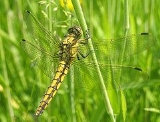
Odonata
Overview
Odonata is an order
of insect
s, encompassing dragonflies
(Anisoptera/Epiprocta
) and damselflies
(Zygoptera). The word dragonfly is also sometimes used to refer to all Odonata, but the back-formation
odonate is a more correct English
name for the group as a whole. Odonata enthusiasts avoid ambiguity by using the term true dragonfly, or simply Anisopteran, when referring to just the Anisoptera.
Fabricius
coined the term Odonata from the Greek
οδόντoς (οδούς), odontos (tooth) apparently because they have teeth on their mandibles, even though most insects also have toothed mandibles.
This order has traditionally been grouped together with the mayflies
and several extinct orders in a group called the "Paleoptera
", but this grouping might be paraphyletic.
Order (biology)
In scientific classification used in biology, the order is# a taxonomic rank used in the classification of organisms. Other well-known ranks are life, domain, kingdom, phylum, class, family, genus, and species, with order fitting in between class and family...
of insect
Insect
Insects are a class of living creatures within the arthropods that have a chitinous exoskeleton, a three-part body , three pairs of jointed legs, compound eyes, and two antennae...
s, encompassing dragonflies
Dragonfly
A dragonfly is a winged insect belonging to the order Odonata, the suborder Epiprocta or, in the strict sense, the infraorder Anisoptera . It is characterized by large multifaceted eyes, two pairs of strong transparent wings, and an elongated body...
(Anisoptera/Epiprocta
Epiprocta
Epiprocta is one of the two extant suborders of the Odonata . It was proposed relatively recently, having been created to accommodate the inclusion of the Anisozygoptera...
) and damselflies
Damselfly
Damselflies are insects in the order Odonata. Damselflies are similar to dragonflies, but the adults can be distinguished by the fact that the wings of most damselflies are held along, and parallel to, the body when at rest...
(Zygoptera). The word dragonfly is also sometimes used to refer to all Odonata, but the back-formation
Back-formation
In etymology, back-formation is the process of creating a new lexeme, usually by removing actual or supposed affixes. The resulting neologism is called a back-formation, a term coined by James Murray in 1889...
odonate is a more correct English
English language
English is a West Germanic language that arose in the Anglo-Saxon kingdoms of England and spread into what was to become south-east Scotland under the influence of the Anglian medieval kingdom of Northumbria...
name for the group as a whole. Odonata enthusiasts avoid ambiguity by using the term true dragonfly, or simply Anisopteran, when referring to just the Anisoptera.
Fabricius
Johan Christian Fabricius
Johan Christian Fabricius was a Danish zoologist, specialising in "Insecta", which at that time included all arthropods: insects, arachnids, crustaceans and others...
coined the term Odonata from the Greek
Greek language
Greek is an independent branch of the Indo-European family of languages. Native to the southern Balkans, it has the longest documented history of any Indo-European language, spanning 34 centuries of written records. Its writing system has been the Greek alphabet for the majority of its history;...
οδόντoς (οδούς), odontos (tooth) apparently because they have teeth on their mandibles, even though most insects also have toothed mandibles.
This order has traditionally been grouped together with the mayflies
Mayfly
Mayflies are insects which belong to the Order Ephemeroptera . They have been placed into an ancient group of insects termed the Palaeoptera, which also contains dragonflies and damselflies...
and several extinct orders in a group called the "Paleoptera
Paleoptera
The name Palaeoptera has been traditionally applied to those primitive groups of winged insects that lacked the ability to fold the wings back over the abdomen as characterizes the Neoptera...
", but this grouping might be paraphyletic.

